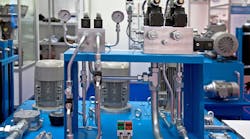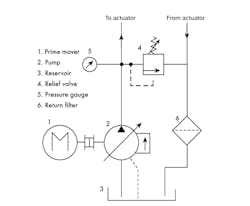To understand the basics of hydraulics, it is best to start off learning about the standard power unit. Once a person knows how this integral system operates, it will be easier to learn about more complex hydraulic systems. Further study can help engineers troubleshoot and validate system designs.
A power unit converts mechanical power into fluid power, which can be used to drive an actuator. An actuator is generally a cylinder, motor, or rotary actuator that is controlled by a directional valve. A power unit must meet the power demands of the system by producing enough force or torque to move the load.
Six basic components, illustrated in the schematic below, make up a power unit. They all work together to transmit power to the actuator and keep fluid clean.
The first component in a power unit is the prime mover. Electric motors are commonly used as prime movers in industrial hydraulics, while gas and diesel engines are more commonly used in mobile hydraulics.
The prime mover supplies mechanical power to the pump via shaft connection. This transfer of energy allows the pump to overcome hydrostatic pressure in the closed circuit, and creates a vacuum relative to the atmospheric pressure, which pushes fluid from the reservoir into the pump inlet, and generates flow throughout the system. There are three basic types of pumps. They are gear, piston, and vane pumps.
Upon exiting the pump, the hydraulic fluid has gained energy, and is exposed to a relief valve and a pressure gauge. The relief valve acts as a safety device to limit the maximum pressure to the power unit. It ensures energy is directed and under control at all times.
If the system pressure gets too high, the relief valve will save the system simply by sending the high-pressure fluid back to the reservoir where it came from. The pressure at the relief valve is indicated by a pressure gauge to provide operational pressure readings of the system.
The fluid proceeds to travel through high-pressure line to transmit hydrostatic pressure to the actuator, which often contains a directional valve. The pressure must be higher than the resistance of the actuator and the load to create work.
Finally, fluid runs through a return filter before flowing back into the reservoir. Clean fluid is necessary in any hydraulic system, so filters are important components in power units.



